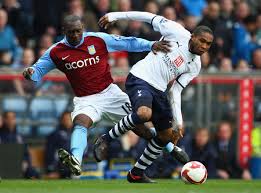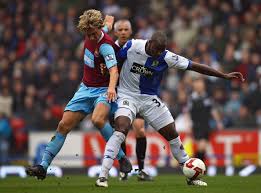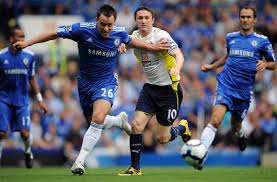 |  |  |  |
English Premier League
England
The Barclays English Premier League (EPL), considered as the best in the world.
Fulham FC vs Tottenham Hotspur
Official name Fulham FC
City London
Founded 1879
Club colors White / Black / White
vs.
0 - 0
Tottenham Hotspur
Official name Tottenham Hotspur FC
City Tottenham
Founded 1882
Club colors Navy Blue / White
Match scheduled:
Date: 26-12-2009
Time: 13:00 until 15:00
Week 19 / Round 19 :: Barclays Premier League 2009/2010
Despite heavy criticism from fans due to Graham's previous association with Arsenal, in his first season as Spurs manager the club secured a mid-table finish and won the League Cup. In the final against Leicester City at Wembley, full-back Justin Edinburgh was sent off after an altercation with Robbie Savage on the hour mark, but Spurs secured a dramatic victory through Allan Nielsen's diving header in the 93rd minute of the game. Spurs also reached the semi-finals of the FA Cup, where they were beaten 2–0 by Newcastle after extra-time. To cap a good season, star player David Ginola won both the PFA Players' Player of the year 1999 and Football Writers' Association Footballer of the Year 1999 awards.
Following the 1999–00 and 2000–01 campaigns, Sugar's patience broke. He sold his controlling interest to ENIC Sports PLC, run by Daniel Levy.
Team management passed to Tottenham legend Glenn Hoddle who took over in April 2001 with the team lying thirteenth in the table. His first game saw defeat to Arsenal in an FA Cup semi-final. The club captain, Sol Campbell, joined Arsenal on a Bosman free transfer that summer. This led to Campbell being vilified by Spurs fans thereafter, and more than seven years after his departure, when Campbell was playing for Portsmouth, he was subjected to a racist and homophobic chant about his disloyalty to the club which led to a host of Tottenham fans being banned from all football grounds in the country for three years, although many of the bans were successfully appealed. [23]
The summer before this managerial change, Tottenham had plunged into the transfer market for their first eight-figure signing when they paid Dynamo Kiev £11million for Ukranian striker Sergei Rebrov. However, Rebrov was not a success at White Hart Lane, managing just 10 goals over the next four seasons (the last of which was spent on loan in Turkey) before joining neighbours West Ham United. [24]
Hoddle turned to more experienced players in the shape of Teddy Sheringham, Gus Poyet and Christian Ziege for inspiration, and Spurs played some encouraging football in the opening months of his management. Season 2001–02 saw Spurs finish in ninth place, as well as reaching the League Cup final, where they lost to Blackburn Rovers, having been the favourites after their 5-1 demolition of Chelsea in the previous round.
The only significant outlay prior to the following campaign was £7 million for Robbie Keane, who joined from Leeds United. 2002–03 started well, with Tottenham in the top six as late as early February, but the season ended with a 10th place finish being the result of a barren final 10 games of the league campaign that delivered a mere 7 points. Several players publicly criticised Hoddle's management and communication skills. Six games into the 2003-04 season, with Spurs struggling at the foot of the table, Hoddle was sacked and David Pleat took over on a caretaker basis until a permanent successor could be found.
In May 2004, Tottenham appointed French team manager Jacques Santini as head coach, with Martin Jol as his assistant and Frank Arnesen as Sporting Director. Santini quit the club in bizarre circumstances in early November. He was replaced by Jol, who turned things around and secured a ninth place finish. In June 2005, when Arnesen moved to Chelsea, Spurs appointed Damien Comolli as Sporting Director.
During 2005–06 Spurs spent six months in the top four, going into the final game of the season, they led rivals Arsenal by a point, but were forced to play their match at West Ham with half the team suffering from Norovirus, a viral form of gastroenteritis, commonly known as "Winter Vomiting Disease". Spurs lost and were pipped to a Champions League place, but it was success nevertheless in gaining a place in the UEFA Cup. They finished fifth for the second season in a row in 2006–07.
Martin Jol was sacked early into the 07–08 season, with Juande Ramos ex-Seville coach replacing the Dutchman. Spurs went on to win the Football League Cup, beating Chelsea 2-1 in the final in February 2008.[2] However, Tottenham endured another dismal start to the season in 2008-09, and in late October a UEFA Cup defeat by Italian side Udinese, combined with terrible league form that saw them bottom of the Premier League, Commoli and Ramos were both sacked. 2008-09 saw the worst start to a season in the club's history.[3] The following day Portsmouth Manager Harry Redknapp confirmed that he had agreed to become the new manager of Tottenham.[3] Director of Football Damien Comolli was also sacked, after criticism of the sales of Dimitar Berbatov and Robbie Keane and failure to replace them adequately. Tottenham returned to a "traditional" setup with Redknapp in charge of coaching and player transfers.[3][4][5] In his first two weeks in charge, Redknapp took the club out of the relegation zone, winning ten out of the twelve points available with wins against Bolton, Liverpool and Manchester City and a 4–4 draw against North London rivals Arsenal. The team finished the 2008-09 campaign 8th in the league table. The January transfer window saw the return of Robbie Keane to the club after an unsuccessful six-month spell at Liverpool.
Spurs have won the first four matches of the 2009–10 season, with Redknapp subsequently awarded the Manager of the Month award and Jermain Defoe the Player of the Month award for August.[6] On 22 November 2009, Spurs beat Wigan Athletic 9–1 at White Hart Lane – a record win in the top flight for the club.[7]
White Hart Lane was originally a disused nursery owned by the brewery Charringtons and located behind a public house. The landlord realised the increased revenues he could enjoy if Tottenham played their matches behind his pub and the club moved in. They brought with them the stand they used at Northumberland Park which gave shelter to 2,500 fans. Notts County were the first visitors to 'the Lane' in a friendly watched by 5,000 people and bringing in £115 in receipts, Spurs won 4-1. QPR became the first competitive visitors to the ground and 11,000 people saw them lose 1-0 to Tottenham.
In 1905 Tottenham raised enough money to buy the freehold to the land and became the permanent owners of the ground. As the club grew new stands were added. A new main stand was added in 1909, the East stand was also covered this year and extended further two years later. The profits from the 1921 FA Cup win were used to build a covered terrace at the Paxton Road end and the Park Lane end was built at a cost of over £3,000 some two years later. This increased the ground's capacity to around 58,000 with room for 40,000 under cover. The East Stand development was finishing in 1934 which increased the capacity to around 80,000 spectators and cost £60,000. The pitch was renovated in 1952 which uncovered a number of items from the old nursery on the site and one year later the first floodlights were introduced. These lights were upgraded in 1957 which required the cockerel to be moved from the West Stand to the East and then in 1961 floodlight pylons were installed.
The West Stand was replaced by an expensive (and far behind schedule) new structure and the stadium started its long modernisation process. Various developments and upgrades were implemented over the years and in 1992 the lower terraces of the south and east stand were converted to seating and the whole of the North stand followed to become all-seater the following season. The South Stand re-development was completed in March 1995 and included the first giant Sony Jumbotron TV screen for live game coverage and away match screenings. The capacity of the stadium increased to just over 33,000. In 1997/98 season the Paxton Road stand had a new upper tier added which included the second Jumbotron screen and increased capacity to 36,240 and was funded by a rights issue in 1996.[9]

The aforementioned 3rd Division hiatus lasted only two seasons though, they were then promoted back to the Second Division as runners-up in 1970-71. This spell also saw Fulham invited to the not particularly prestigious Anglo-Italian Cup, which saw the club draw four out of four games in two appearances in tournament between 1972 and 1974. Thus started of a period of high-profile signings for the club under Alec Stock in the mid-70s, including Alan Mullery and Bobby Moore. The reward of this was their only ever FA Cup final in 1975, having won their first semi-final in five attempts. The club then lost to West Ham in the final. This gained the club qualification to another low-key European tournament, the Anglo-Scottish Cup, where they made the final, losing to Middlesbrough.
That run in the FA Cup saw the setting of an improbable record, that of the most games needed to reach the final, Fulham playing 11 games including replays. In the build up to the 12th game, the Wembley final, Tony Rees and The Cottagers released a single, "Viva el Fulham" (based on Manolo Escobar's "Y viva España") which is still played (and occasionally chanted) at Fulham games. It reached No.46 in the Pop Charts in 1975. The club set another record in the 70s, when they took part in the first ever British league game to be played on a Sunday against Millwall F.C. in 1974, which was staged at The Den.[16]

The following season saw Fulham dangerously close to the relegation zone, and chairman Mohammed Al Fayed told Tigana that his contract would not be renewed at the end of the season. But an awful run of results, culminating in a 4-0 home defeat by Blackburn Rovers led him to be sacked before the season came to an end with relegation desperately near. Jean Tigana made the club's record signing, buying Steve Marlet from Olympique Lyonnais for £11.5 million. He failed to live up to expectations playing only 54 league games in 3 years, and scoring only 11 goals. He was loaned out to Olympique de Marseille for 18 months when Coleman took over, with his sizeable contract still being paid by the English team, before it eventually expired.
Coleman was given the manager's job on a permanent basis in the summer of 2003 and despite predictions that the inexperience of Coleman would result in Fulham's relegation,[23] he kept the club well clear of relegation, guiding them to a club record ninth place finish in his debut season. This might have been greater had the club not come under significant financial pressure to sell Louis Saha to Manchester United, for which they received a club record £13 million. The final day of the season saw them win 2–0 away to Bolton.
Coleman notched up another impressive performance in the 2004–05 season and guided Fulham to a secure 13th place finish.
The 2005–06 season proved a tougher affair, but safety was once again mathematically assured with three games left of the season and a 1–0 win over Wigan Athletic. There were three relative high points in an inconsistent season: a 6-1 rout of West Bromwich Albion, a 1–0 win over rivals and champions Chelsea in the West London derby, and a 2–0 win over 2005 European champions Liverpool F.C. Fulham's home form was the best outside the top six, with 12 wins from 18 games, while their away form was the worst in the entire league with one win and four draws from 18 games. A game they were winning away 1–0, versus Sunderland, was abandoned after 21 minutes because of persistent snowfall. Finally, on 29 April 2006, Fulham achieved a first away victory of the campaign with a 2-1 win over Manchester City F.C. Despite the difficulties experienced throughout this season, Fulham achieved a 12th place finish — an improvement on the previous campaign.
Fulham did not get off to a good start in 2006–07, losing their first match 5-1 to Manchester United at Old Trafford. This result consigned them to the foot of the table and left them as the season's favourites for early relegation contenders with the bookies; but then recovered well and were riding as high as 8th at one point in December 2006.
During the January transfer window Coleman added Russian midfielder Alexey Smertin, American winger Clint Dempsey, and Welsh compatriot Simon Davies to the squad, and captured exciting loan signing Vincenzo Montella. Between mid-December and May however, Fulham only won a single game, a 2-1 victory over Newcastle United. In the same time period Fulham drew 9 games and lost 4. Additionally Fulham were dumped meekly out of the FA Cup 4–0 by Tottenham Hotspur. On the 10 April 2007, following defeats at the hands of Manchester City (3-1) and Everton (4-1) Fulham Football Club terminated the contracts of Chris Coleman and Steve Kean with immediate effect, while Northern Ireland manager Lawrie Sanchez and Les Reed were put in temporary charge.
 |  |  |

















